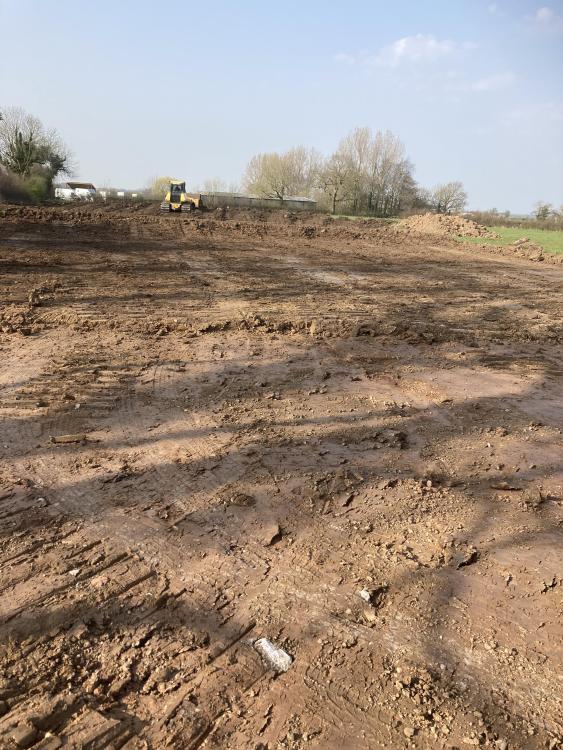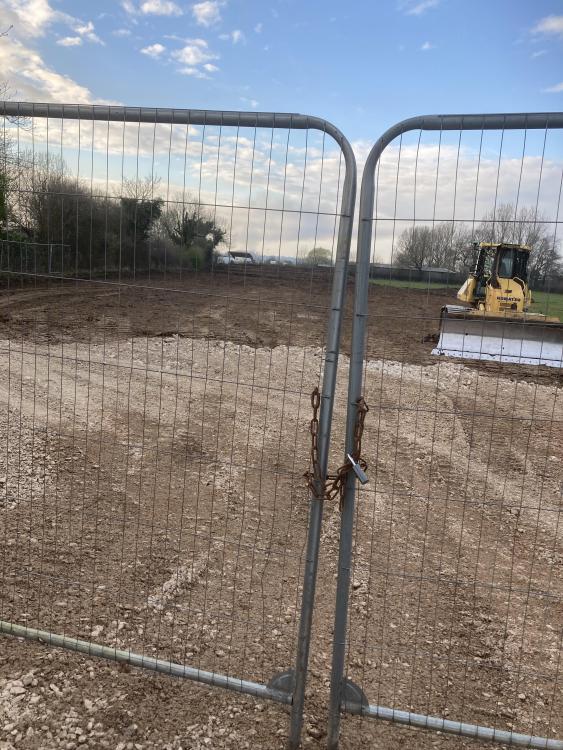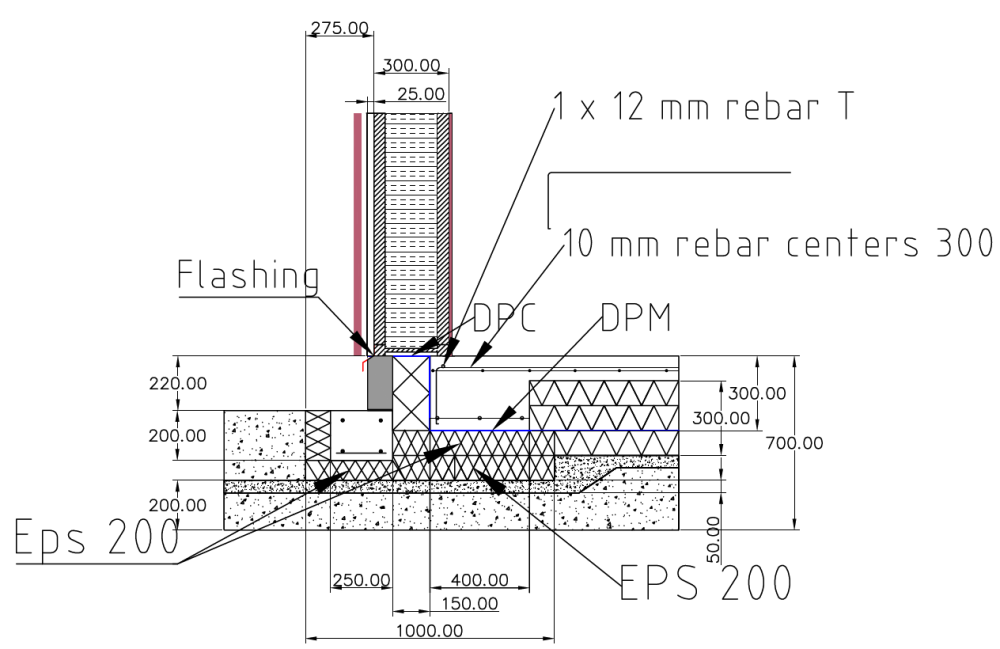Leaderboard
Popular Content
Showing content with the highest reputation on 03/24/22 in all areas
-
6 points
-
As predicted, progress has been a bit slow. We've been working away on internal joinery/finishing and a bit of outdoor landscaping when the weather allows (in-between baby-management and working). We got our building warrant completion cert. and VAT reclaim back about a month ago which has also helped. Costs For reference, our finalised costs were just shy of £1300/sqm including all professional fees/admin, site setup, construction and fitting out costs. I think this is a fair reflection of the amount of work put in by us vs labour bought in. We had some fairly labour intensive jobs, such as trenching the water pipe ~300m through the woodland that, while they took us quite a while, we would have paid a lot of money (and likely had a lot more destruction) if we'd paid someone else to do it. We did spend quite a bit on labour for the groundworks/founds, framing, plasterboarding, electrics and plumbing, insulation and some finishing joinery. The bulk of the spend was prior to the significant materials price rises. Knocking all the labour costs out and it becomes possible to see where you get closer to £1000/sqm. It's been tricky enough juggling work, looking after small children and trying to finish building and so while reducing the costs might be feasible I hate to think what situation we might be in now if we had tried to do everything ourselves (add in the materials price rises recently and I'm also more relaxed about not drawing it out). The house We've now spent a good chunk of our first winter in the house. Our main heating is a woodburner, with a few direct electric radiators as a backup. We light the stove for a few hours in the evening most days when it's cold (say 0 and below) and every other day for an hour or so if it's milder (~5 degrees ish outside). We've used a small wood store's worth of timber. Despite a relatively poor airtightness test result compared to some others on here the house seems to hold heat well and is fairly comfortable. Finishing off We're now mostly in the realms of landscaping. We're not a massive fan of patio slabs, but wanted somewhere to sit outside. In the end we got hold of a load of broken bits of caithness sandstone, bought by the pallet from stonesource in Inverness. Quite heavy and time-consuming to work with but very solid and the variation in the stone gives a nice finish.4 points
-
3 points
-
Pipe through fascia, run under window to right, 45 bend into branch. Good luck. Looks lovely! P.S. if the angle ain't quite right warm the pipe up a bit. M2 points
-
An extract below a window would be really ineffective at doing what you want from it. What's the room and ceiling layout? There's usually a way to find a solution. The extract needs to be as high as possible, and ideally far away from the door (if not immediately above or adjacent to the shower).2 points
-
Have a read of the manufacturer instructions, they will give you clear guidance on where and where not to install. You really want to extract at a high level where the steam is, not as it's condensing and coming down. You also should either extract above shower/bath or close by2 points
-
2 points
-
2 points
-
Really not advisable to use a 117mm core bit in an SDS - they are not made for it and there is no slip clutch on an SDS drill so when it catches on something in a dense block it will spin and break your wrist or smack you in the face … Go hire a core drill unit and do it properly.1 point
-
1 point
-
I very much doubt it but I think the ‘how long has it been occupied for in the last 12 months’ is really for existing dwellings rather than new self builds so not sure that you would need to lie anyway.1 point
-
Took the small trampoline down to make a bit of space and decide where the veg patch is going. The hedge faces SW. Beam trench will come out from the hedge at 90 degrees. Some quite thick tufts and a big patch of ivy to the lhs of the barrow. What to do with this lot?1 point
-
1 point
-
Yes I think almost everyone would advise against a treatment plant with moving mechanical parts such as the one you mentioned. There are many on here with different variations on the air blower treatment plants and I think most are happy with them. From memory the plants used by forum members are Vortex, Conder (me) Graff and Bio Pure. The manufacturers all seem to be a little lacking with quietness and tend to put the air blower in a plastic box that can often act like a drum and make the noise worse. In those cases people have had good results taking the blower out of the unit and building a brick or concrete box to house it instead. You don't want to be putting baby wipes, cotton buds certain womens products etc into a treatment plant. The old saying is don't put anything into it that you have not eaten first. And avoid bleach and use more friendly cleaning products. All treatment plants need emptying (desludging) every couple of years.1 point
-
Hmm. I assume this is front of the house, and that's a garage below? If so, can you take the central downpipe straight down vertically to the point you can get it through the wall into the garage, do the diagonal bit out of site, then bring it back out into the right hand downpipe? Still not ideal, but a bit more symmetrical. You could do you internal bit with soil pipe fittings to sort out any problems with angles. On second thoughts, maybe do the right hand and central downpipes the same way, and run them internally to the left hand downpipe.1 point
-
Or ask for approval for expected total amount of batteries and PV as it cost us £ 360.00 a time....1 point
-
I am (or was) a Chartered Surveyor for 25 years until I got fed up of paying the RICS £700+ a year for nothing in return apart from a monthly mag that I chucked in the bin with the plastic intact. So, let's have a look at this - or a job like this, do we need a Party Wall Agreement as well as a Licence to Alter? Party Wall - probably not. License certainly yes. With reasonable L/L costs covered. This can be legal and surveyor's monitoring costs. Can they object to the work on grounds of noise and disruption? [no - covered in the License] One of the couple in the 2 bed flat works with vulnerable children, is WFH since the pandemic so does everything on video calls, doesn't have an office to go to.[Not your problem] She and her husband do however have two large double bedrooms on the second floor at the top of the house. He works in one, she works in their living room which is directly above my living room where a lot of the work will be done. [sucks to be them for a few days] I've suggested they both work on the second floor away from the noise but they don't want to and haven't given me a good reason. Is this something a surveyor would be able adjudicate on in the event of a dispute, or are we getting into legalities beyond a surveyor's scope? [none of this is your problem - smash it out and all is done - it is not like you are building an effig motorway outside the house ffs. The kitchen of the new open-plan space will be below the bedroom of the 1-bed flat. Can the owner object to the new configuration on the basis of potential extra noise from the kitchen and living room below? If so will sound-proofing the ceiling be enough to address this? [No - in fact you suffer their impact noise x10 to what you will make. I lived in a GF flat conversion in Finsbury Park 30 years ago with all of the impact noise above and went to sleep dreaming of getting an Uzi and hosing the rest of the house down!1 point
-
1 point
-
Sand the pipe down, primer and paint to match house. on my last place all pipes where painted to match walls,1 point
-
With the floor installation you have, I would go UFH in screed. Small system boiler, not sure if you get them but one where you can run the heating circuit at a lower temp than the DHW. Unvented cylinder. Your UFH will come on once per day for a few hours and shut off until the next day, irrespective of what you want it to via thermostats. Run the whole ground floor as a single zone from a single timer thermostat. No need for anything fancy, as they will not work as required in a high performance house. I took my thermostat out except one in the living space and one in each bedroom, as we are in a bungalow. Put electric towel rails in bathrooms. Ask yourself do I need heating in the bedrooms as the heat will move upwards and they will be heated anyway. I went slightly different route. Combi with thermal store upstream, to collect PV immersion heat; to offset gas costs in the summer, the boiler takes the preheated water up to 55 degs (via mixing valve) it adds heat if it needs to only. Will also be adding solar thermal in a couple of months also, to help displace heating costs in the shoulder months. Boiler works with no short cycling as the UFH manifold (temp set at 30) is fed from the thermal store. Boiler heating circuit is used to heat thermal store to 34 deg (no real losses from the cylinder) with a 4 deg hysteresis. Boiler heating flow set to 40. When running the boiler runs for about 15 to 20 mins and slowly creeps up to a max allowable temp of 55. Then spends about 10 to 15 mins resting. (Still making changes to setting to get it to run most efficiently).1 point
-
1 point
-
Absolutely I'm familiar with typical twin-stud and Larsen truss wall build up, but MBC's twin stud uses 89 x 37 section size. As a typical framing section, it's logical the vertical loads can be carried through just one side of the twin-stud, allowing the other to overhang a non-loadbearing insulated upstand. For the I-Joist in the image, the flanges are 45 x 47, and finger-jointed. To my knowledge this isn't a typical framing section, and with the outer flange sitting over EPS 100, it's not going to be taking any load. For this reason, the detail I'm familiar with for a thermal bridge free slab detail with I-Joists is a little more complicated than required for a twin-stud and looks like this: A simpler, but not quite thermal bridge free detail is: Where the EPS L former width is reduced at the top to get the concrete slab under the outer flange, to support it. Don't get me wrong, I like the detail shown with the unsupported outer flange of the I-Joist, and an SE must have been happy to sign it off, but it doesn't follow I-Joist principles I'm familiar with. In fact, I needed to provide additional calcs for BC to convince them the outer ring-beam in the first image above could take the loads that would come through the outer flange, with "just" 100mm of EPS beneath.1 point
-
a friend who worked for BT many years ago asked why they were putting a cable into a garage and was told it was a house foundation. it was for a 'box company' so understandable.1 point
-
Yes, you do need to advise the neighbours formally, but it does not require a party wall surveyor unless the neighbours want it.....you pay.1 point
-
If possible, try to find a room in another building a similar size and then walk around in it. As all above, the perception of size changes as the build progresses and as said, it’s not linear. Rooms feel small and much larger and smaller again etc until completion.1 point
-
Perspective changes as the rooms grow from an outline on the ground to fully built. Even then, an empty room can look smaller than a furnished one! Make decisions on the measurements and comparison to rooms in other houses.1 point
-
Keep it simple. Keep boiler, PV on roof to offset your day to day usage and a solar diverter to heat your UVC during the sunny days. Go to town on your extension air tightness and insualtion (200mm full fill cavities, 150mm PIR in floor or 300mm EPS, basically passive standards) so your minimising the additional heat load of the building replace your crappy double glazing with decent triple.1 point
-
Site worth a read. Lots of info on getting best from your system https://www.heatgeek.com/category/knowledge/balancing/1 point
-
Our house Tradesmen, seeing our slab, that house is huge. Wife, it's tiny Walls up, it tiny, internal walls up it's tiny, plasterboard up it's tiny. First coat of whit paint, it's huge, did we need room that big!1 point
-
That's underground pipe. It's not UV stabilised and should not be used above ground. You want to replace that pipe with either the same type and cover it, or black PVC pipe to ground level bend and cover. It wouldn't be hard to pull those apart and replace. Likely the seals have pulled out or the pipe has become porus. You need to make sure the bottom bend has a duck foot and is set firm, and the vertical pipe is clipped to the wall or a support. Finally, is there a vent pipe or air admittance valve on that branch? From the description it's just servicing a single toilet then presumably connects to the sewer outside.1 point
-
The smell is likely hydrogen sulphide, produced from the breakdown of matter in sewer pipes. The pipes you show have seals in the fittings. Two initial observations: 1) I can't be 100% sure from the photos, but those pipes look like they are rated for underground use only, typically supported by bedding material. 2) In an arrangement like that, with an unsupported length of pipe, it's possible that the seal is either damaged through movement or the pipe is not sitting in the fitting cleanly leading to escaping air. This is possibly more likely to be noticed when you flush a loo as it will push air out through any gaps in the pipework. Two things you could consider. First is to try and air test the pipe work, this will let you know if there is a leak. It will depend on how easy access is up/downstream of the pipework. Secondly, you could replace the pipework with appropriately rated and supported external pipework.1 point
-
Yes been there, done that got the tee shirt. I have even hears rumours of some builders who enlarge the building having seen it is "too small" then it becomes massive when built.1 point
-
1 point
-
If you are standing in a shower, only the bits which "hold water" are zone 0. The walls above the "tray" are zone 1. Plenty of ipx4 fans available1 point
-
I really think you need a planning consultant’s help with proving the other sites you own aren’t acceptable at a minimum. There might be scope to do farmworker’s accommodation or even use some outbuildings to justify a dwelling that way. There’s lots of things you could do other than just fire applications at the council. I think a pre-app is a waste of effort usually.1 point
-
1 point
-
Take it back to the wall as you have but run it at a much shallower angle as close to under the eaves as possible? In a lighter/cream finish to match the render too?1 point
-
Hi everyone. Nothing too exciting here. Recently bought a 1950s ex-council house and aiming to lower energy consumption as far as reasonably practicable. Found your excellent website just before a self-building friend recommended it, too, and will probably lurk and read a lot and ask a few questions. Thanks in advance for all the great advice.1 point
-
This. A million times this. If I was to pick only 1 reason to go down the route of building our house from scratch versus a refurb or buying a pre-built house - it's exactly what you've described below. There's usually a very clear decrease in room sizes as you go from Master Bedroom to Bedroom 2, then Bedroom 3 and beyond. I don't think I've EVER seen a house which had been designed with 2 kids in mind (i.e. identically sized bedrooms) unless you go into the super luxury homes upwards of £2m or so. It was also the 1st and most important instruction I gave my architects, to have them matching in size to the millimetre!1 point
-
Indeed and because we only have one kid, we designed the house with 2 big bedrooms one for the adults and one for the kid, with the third smaller room as a guest bedroom for visitors. What I dislike about many of these off the shelf "Scottish" designs is they put at least one bedroom downstairs. I would prefer not to have the vaulted living room in that design if it meant I could get all the bedrooms upstairs. but that is a personal thing. Re planning. If it is anything like here, there is a general presumption against building in the open countryside. The exceptions are in an existing settlement, infill between existing buildings and if the plot is existing garden ground. I have known applications refused by being just a few metres outside the existing settlement. Ours passed on both the infill between existing buildings and inside the existing settlement. And once they have accepted you can build something, they generally will not allow full 2 story, it must have some element of room in roof.1 point
-
Hungary has a relatively small pot of common names, so it is common to have people with the same name in a group of friends. It makes me wonder what taking the register is like in school 😂 And they have ‘name day’ on which your name is celebrated like a birthday. Today is Gábor and Karina day. I speak basic Hungarian, although have forgotten a great deal of it now. It is quite a challenging one to speak well. I’ve never progressed beyond sounding like a toddler 🤣1 point
-
the biggest thing that frustrates me about these 'off-the-shelf' products and also mass built houses is the fact that the 2nd and 3rd bedrooms are always different sizes! it's like I'd have to decide which kid I loved more and give them the biggest room. the beauty of designing your own house, whatever route you'd choose to do that, is you have the flexibility to do what *you* want. one of the first things we said to our architect was we wanted the kids bedrooms to be the same size. why should one child lose out to the other one!1 point
-
Got it from my architect's store in Ballymena, https://ecohomesstore.co.uk/products/products/varafluid-blowerproof-liquid-airtight-membrane/varafluid-blowerproof-liquid Tho the one I had was smaller ended up buying a second one so reccomended you get the big tin. So much handier than tape for likes of door blocks, window sills, wall plates etc.1 point
-
You only need him to do a design and get Planning Permission and Building Control Approval. Tell him that’s all you need and get him to re-quote his fees. He will more than likely need to appoint a SE on your behalf (depending on the design). Do your own SAP CDM and tendering. Ask him for an hourly rate to be on the end of the phone during the construction phase. Let him do any survey - put as much liability in his lap as you can. Giving him measured surveys that you have done is asking for trouble. If you are self building and organising the trades yourself there is no value in him tendering the works - all he will do is send out his drawings to a few main contractors and as a self builder this is not what you want. Be aware that the drawings he produces for building control will not necessarily be good enough to tender from. Ask him for a cost to produce proper construction drawings for you. My building regulations drawings will always go a wee bit above and beyond and will allow the client to tender the majority of the works. I don’t do door or window schedules or specify specific kitchen or sanitary ware fittings and fixtures. Good luck.1 point
-
1 point
-
Seems like only when installed! Although this is tipping the balance now towards me just using my relatively inactive Ltd company to branch out into energy-saving material installation. If I VAT register through election (currently only turn over a little bit so below the threshold in planning consultancy/design), I can then install all of our insulation (~15k's worth) and even with me paying my Ltd company a nominal labour rate for the installation, if it's all zero rated, it will save a decent amount. Otherwise I'm either paying 20% on anything I DIY install (as it's a renovation not a new build), or I get 0% on installed materials but paying someone the labour will wipe out any savings. Although I am pleased that we were delayed in getting the cavity wall foam insulation - that should give a modest £400 saving by losing the 5%. All this of course assumes that the firms won't just up their prices by 5% to offset the VAT...1 point
-
We used liquid air tight paint for the door block / floor/ wall junction. Tape wouldn't stick properly to the rough surfaces.1 point
-
If you have a concrete floor and block walls, would it not be easier to use a liquid brush on product, no kneeling down. pour on and use a cheap broom 2 coats. Any big gaps you can incorporate a reinforcement mesh.1 point
-
No problem. I haven't used Siga myself but Siga has a very good reputation for quality products. Siga Fentrim 20 should be fine as it's for connection to solid surfaces and you can plaster over it. If you do a search on the forum you'll find loads of preferences, another of which is Tescon Vana. I've used a number of products but mostly Gerband tapes from Passivhaus Systems. I've also used a lot of the Soudatight LQ for floor to masonry wall junctions as there a lot of old masonry to deal with and the liquid follows the undulations better than tapes I've found.1 point
-
Maybe I’m not the right person to answer this as I have an interior design qualification but I think self builds are a very personal choice, we have all put a lot of time and effort into the design and build and have already made a lot of choices regarding materials and have a vision of what we hope to achieve and this includes the interior. In our last build I had the interior designed before the house was completed, this time we were once again refurnishing the whole place other than beds but I decided to live with the basics until I got a feel for the place and within a few months I had it in my head how it should look. I think most self builders work to a very tight budget and as the build progresses and things don’t always go to plan , unforeseen costs crop up and very few would have the spare funds at the end of the build to then engage an interior designer.1 point













.thumb.jpg.bac90f3bbf6868cf2118d010d936c99d.jpg)




